|
Just about every hunter at one time or another
dreams about Africa. As young kid, I read everything that
I could on the subject of hunting the Dark Continent, especially
the writings of Peter Hathaway Capstick, and later the
eloquent prose of Finn Aagard. It was eloquent to me
anyway. Elmer Keith also wrote of hunting Africa, as did
many others. I read it all, never really thinking that I could
someday go over there, but it is good to dream.
Most riflemen also endeavor to some day own an
African Rifle. Not a rifle made in Africa, but a rifle suitable
for hunting the world’s largest and most dangerous game. Even
without the real need for one, most hunters still have a desire
to own a truly dangerous game rifle, for whatever reason.
Perhaps it is to fuel the dream. In the early days of African
hunting, the rifles were truly large-bore single shot
muzzleloaders, but later gave way to the elegant English and
European single-shot and double cartridge rifles. These
rifles were expensive even in the late nineteenth century, and
were usually carried by the gun bearer of the wealthy hunter.
With the introduction of the bolt action magazine rifle,
suddenly, affordable rifles were available to just about every
hunter. Along with these weapons came the grand old cartridges
introduced for the rifles, to pursue the large game of Africa
and India. These cartridges were introduced mostly by the
British firms of Wesley-Richards, Rigby, Holland
& Holland, and Birmingham Small Arms, along with
other British and European gun makers. One thing that these
magnificent old cartridges have in common is that they were
designed to feed from a magazine smoothly, and to extract easily
after firing. They had a long, gentle taper for the most part,
making feeding and extraction easily accomplished under harsh
conditions. When facing dangerous game, reliability of the
weapon was, and is, of the utmost importance. The weapon had to
work, every time. Contrast this with many of today’s ultra fat
squatty magnums, and I will take the long tapered old cartridges
every time. They are simply more reliable in a magazine rifle.
They operate at lower pressures than do the latest magnums,
which also eases extraction in extremely hot weather. The
supposed drawback to these older magnum cartridges is that they
require a long action, and today many shooters, for whatever
reason, desire the shortest action possible, which also adds to
the problem of getting fat cartridges to reliably feed from a
magazine. I believe that the mistaken need for lighter and
lighter rifles is the main contributing factor in this. A
lighter rifle is easier to carry up a mountain or to pack all
day even on flat ground, but trading reliability for lighter
weight is unwise. A hunter would be much better off losing ten
pounds from his waist than from shaving a pound or two from his
rifle, if he must compromise reliability to do so.
At any rate, most new rifles introduced these
days are of the shorter, lighter variety, and true magnum-length
bolt actions are fewer and farther between than they should be.
While some rifle manufacturers rework their standard-length
actions to accept the genuine original magnum cartridges, a few
still build a magnum-length action. One such maker is Ceska
Zbrojovka, better known as CZ, located in the Czech
Republic. CZ produces a true magnum Mauser type action,
along with other rifle and handgun designs.
A few months ago, I received for review from CZ-USA,
the CZ affiliate in the United States, one of their Safari
Magnum rifles chambered for what is arguably the best big game
cartridge ever introduced; the .375 H&H Magnum. The .375
H&H has taken dangerous game from Alaska to Zimbabwe, and
every other corner of the world. It is not the biggest and
baddest of the magnums, but it works and works well. It is
certainly the most versatile of what are considered African
cartridges, and I deem the grand old .375 H&H to be one of
the best and most useful cartridges extant.
The version sent to me is the CZ 550 American
Safari Magnum, which differs from their regular Safari Magnum in
stock design. The American version has a straighter buttstock,
which is preferred by most American shooters. The CZ
Safari Magnum is, as stated above, based on a true magnum Mauser
length action. It has that wonderful, big, claw extractor which
not only ensures reliable case extraction, but that also holds
and guides the cartridge from the magazine into the chamber;
that system which is dearly referred to by shooters as a
"controlled round feed action". This is opposed to a
push-feed action which, as the name implies, simply pushes the
cartridge from magazine to chamber. While both systems work,
most knowledgeable hunters and professionals prefer the
controlled round system for reliability.
The CZ Safari Magnum wears a medium-heavy
twenty-five inch long barrel that is fitted with a three-leaf
folding rear sight that is regulated for 100, 200, and 300
meters, with the 100 meter sight being rugged and non-folding,
as it should be on a dangerous game rifle. The rear sight base
is adjustable for windage. The front sight is hooded, and has
interchangeable posts to adjust for elevation. The internal box
magazine on the Safari Magnum holds five cartridges in reserve.
I could easily load six into the magazine, while closing the
bolt chambers the first and leaves plenty of room for the
remaining five. Many magnum rifles on the market only hold two
or three cartridges in reserve. The CZ deserves points for a
well-designed magazine. The all-steel magazine floorplate drops
to empty the magazine by pressing on a button at the front of
the trigger guard. No malfunctions occurred during testing. It
released when wanted, but held tightly closed during firing.
The CZ Safari Magnum rifle has a single set
trigger that is activated by pushing forward on the trigger
until it sets. As adjusted from the factory, the trigger
released at just over one and one-half pounds in the set mode,
and released at three pounds and six ounces in the normal mode.
Both settings are adjustable, but I left them as they were, for
the trigger pull was very good already. The American version is
available with plain or fancy walnut stocks, or in three
different color patterns of laminated wood, with the colors on
the test rifle being mostly green and brown. With the
laminated stock, the sample rifle weighed just over ten pounds,
which gave the rifle a solid but well-balanced feel. The forearm
and buttstock are checkered for a positive grip, and sling
swivel studs are factory installed. The buttstock wears a Pachmayr
Decelerator recoil pad, which, along with the heft of the rifle
do a good job of attenuating the recoil.
The square-bridged magnum Mauser action has
scope mount bases milled into the top of the front and rear,
which is a nice feature. When ready to fire, from the rear of
the bolt protrudes the back of the firing pin, which serves as a
visible and tactile cocking indicator. Pressing in on a button
at the left rear of the bolt shroud releases the bolt for
removal. The bolt can also easily be stripped for cleaning.
The manual safety is a two-position button that is pushed
forward to fire, and when pulled to the rear locks the bolt
handle in its downward position.
While the Safari Magnum wears excellent open
sights, the .375 H&H cartridge can benefit from the use of a
good riflescope, as it is a relatively flat-shooting cartridge
compared to many dangerous game cartridges. A low-powered
variable scope is ideal on a rifle such as this. It adds greatly
to its versatility. The power can be cranked up for the
occasional three hundred yard shot at game, but still allow very
quick shooting when set at its lowest power. The .375 has a
trajectory much like a .30-06, and can be used out beyond the
practical range of the express open sights. I mounted what is
most likely the perfect scope for this rifle and cartridge; a Leupold
2 to 7 power VX-II. This scope is relatively compact and
lightweight, weighing only 10.1 ounces, but it has plenty of
power, and is just eleven inches long. It has a 33mm objective
lens, is multi-coated, and best of all, has almost five inches
of eye relief! I mounted the VX-II in Leupold rings that are
made especially to fit the CZ receiver. These rings are very
rugged, but with the little pocket-sized wrench provided, allow
the scope to be removed in about ten seconds if necessary in the
field by loosening two Torx screws. The VX-II is perfectly sized
for the Safari Magnum, has wonderful optical clarity, and
legendary Leupold durability.
Shooting the CZ Safari Magnum proved to be a
pleasure, even from a benchrest. The weight, recoil pad, and
stock design worked very well to soak up the recoil, and the
generous eye relief of the Leupold meant that I did not have to
worry at all about the scope cutting my brow. Accuracy testing
was conducted at a range of one hundred yards using Hornady
factory 270 grain soft point ammunition. Function testing
was done using that 270 grain load, along with Hornady 300 grain
solids. Functioning of the CZ was perfect, with no failures of
any kind. Cartridges fed smoothly and extracted easily, thanks
to that big claw extractor, and to the excellent shape of the
.375 H&H cartridge. The CZ also has a fixed steel ejector,
which assures flawless ejection of the fired case. Accuracy was
very good with the Hornady ammo. The CZ would group five bullets
into just under one and one-half inches with ease.
The CZ 550 American Safari Magnum is an
exceedingly well-built rifle. In addition to the .375 H&H
cartridge, it is chambered for the .416 Rigby, .458 Winchester
Magnum, and .458 Lott cartridges. It is arguably the best
rifle of its type on the market today. It is constructed of wood
and steel, it has an excellent trigger, good accuracy, superb
sights, and is priced considerably below its competition. It
also has a greater magazine capacity than any competitive rifle
available. The Safari Magnum is built on a time-tested and
proven action, and is chambered for cartridges capable of taking
any game on Earth.
Gunblast.com has been working with an outfitter
in South Africa for about a year and a half now, trying to put
together a hunt package for our readers. It will most likely
happen sometime this coming summer. For a bolt action African
rifle, I cannot think of anything better than this CZ 550 Safari
Magnum for that trip. Hopefully, CZ will someday offer it in a
left-handed version also, but for right-handed shooters, this CZ
is the classic African hunting rifle, and I highly recommend it.
For more information on the entire line of CZ
rifles, handguns, and shotguns, go online to: www.cz-usa.com.
For a closer look at the extensive line of
quality Leupold optics, go to: www.leupold.com.
For the location of a CZ dealer near you, click
on the DEALER LOCATOR icon at: www.lipseys.com.
Jeff Quinn
|
To locate a dealer where you can
buy this gun, go to: |
|

|
  
Got something to say about this article? Want to agree (or
disagree) with it? Click the following link to go to the GUNBlast Feedback Page.
|
|
Click pictures for a larger version.

CZ 550 American Safari Magnum Bolt-Action Rifle in .375
H&H.
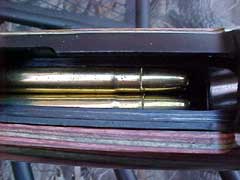
The CZ Safari Magnum is a true magnum-length action.
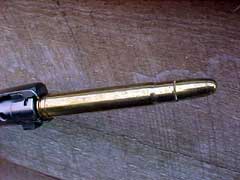
C
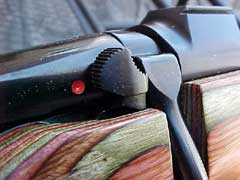
The CZ 550's manual safety is easy to use and reliable.
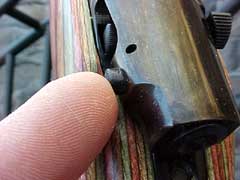
Bolt release button is conveniently located.
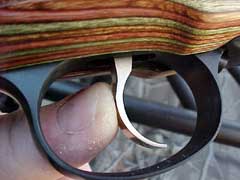
Single-set trigger is operated by pushing the trigger
forward for a lighter pull.
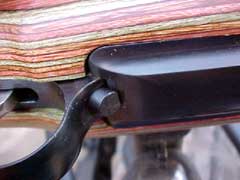
Floorplate release for the well-designed magazine is
located just forward of the trigger guard.
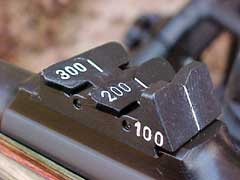
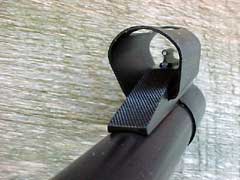
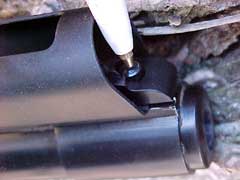
Iron sights are rugged, well-regulated and quick to use.
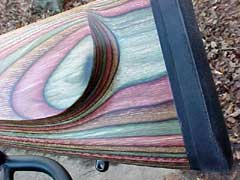
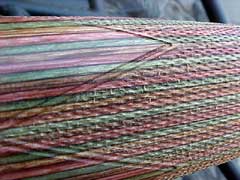
Among the stock options available for the CZ 550 is this
well-designed and nicely-checkered laminated stock with
Pachmayr Decelerator recoil pad.
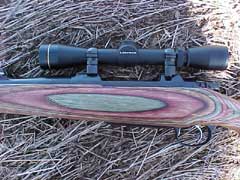
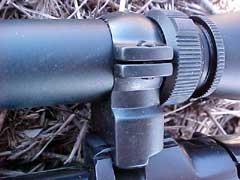

For scope sighting the CZ 550, a shooter can do no
better than



Hornady produces some excellent factory loadings for the
.375 H&H.
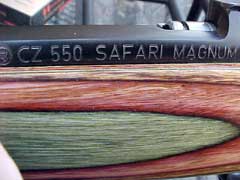
|
![]()